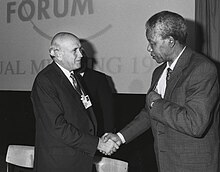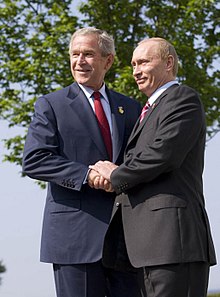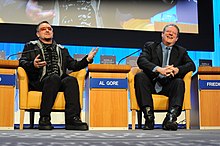History of Western civilization
This article needs additional citations for verification. (May 2024) |
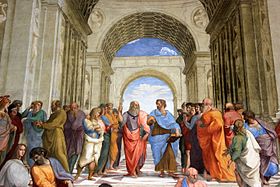
Following the 5th century
The Industrial Revolution began in Britain in the 18th century. Under the influence of the Enlightenment, the Age of Revolution emerged from the United States and France as part of the transformation of the West into its industrialised, democratised modern form. The lands of North and South America, South Africa, Australia and New Zealand became first part of European empires and then home to new Western nations, while Africa and Asia were largely carved up between Western powers. Laboratories of Western democracy were founded in Britain's colonies in Australasia from the mid-19th centuries, while South America largely created new autocracies. In the 20th century, absolute monarchy disappeared from Europe, and despite episodes of Fascism and Communism, by the close of the century, virtually all of Europe was electing its leaders democratically. Most Western nations were heavily involved in the First and Second World Wars and protracted Cold War. World War II saw Fascism defeated in Europe, and the emergence of the United States and Soviet Union as rival global powers and a new "East-West" political contrast.
Other than in Russia, the European empires disintegrated after World War II and
Antiquity: before AD 500
The Middle Ages
Early Middle Ages: 500–1000
While the Roman Empire and Christian religion survived in an increasingly Hellenised form in the Byzantine Empire centered at Constantinople in the East, Western civilization suffered a collapse of literacy and organization following the fall of Rome in AD 476. Gradually however, the Christian religion re-asserted its influence over Western Europe.
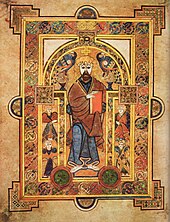

After the
Pope Gregory the Greatmade himself in Italy a power stronger than emperor or exarch, and established a political influence which dominated the peninsula for centuries. From this time forth the varied populations of Italy looked to the pope for guidance, and Rome as the papal capital continued to be the center of the Christian world.
According to tradition, it was a Romanized Briton, Saint Patrick who introduced Christianity to Ireland around the 5th century. Roman legions had never conquered Ireland, and as the Western Roman Empire collapsed, Christianity managed to survive there. Monks sought out refuge at the far fringes of the known world: like Cornwall, Ireland, or the Hebrides. Disciplined scholarship carried on in isolated outposts like Skellig Michael in Ireland, where literate monks became some of the last preservers in Western Europe of the poetic and philosophical works of Western antiquity.[12]
By around 800 they were producing illuminated manuscripts such as the Book of Kells. The missions of Gaelic monasteries led by monks like St Columba spread Christianity back into Western Europe during the Middle Ages, establishing monasteries initially in northern Britain, then through Anglo-Saxon England and the Frankish Empire during the Middle Ages. Thomas Cahill, in his 1995 book How the Irish Saved Civilization, credited Irish Monks with having "saved" Western Civilization during this period.[13] According to art historian Kenneth Clark, for some five centuries after the fall of Rome, virtually all men of intellect joined the Church and practically nobody in western Europe outside of monastic settlements had the ability to read or write.[12]
Around AD 500,
Only in 732 was the
Charlemagne ("Charles the Great" in English) became king of the Franks. He conquered Gaul (modern day France), northern Spain, Saxony, and northern and central Italy. In 800, Pope Leo III crowned Charlemagne Holy Roman Emperor. Under his rule, his subjects in non-Christian lands like Germany converted to Christianity.
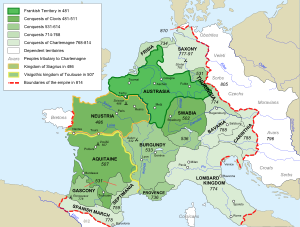
After his reign, the empire he created broke apart into the kingdom of France (from Francia meaning "land of the Franks"), Holy Roman Empire and the kingdom in between (containing modern day Switzerland, northern-Italy, Eastern France and the low-countries).
Starting in the late 8th century, the
By the beginning of the 11th century Scandinavia was divided into three kingdoms, Norway, Sweden, and Denmark, all of which were Christian and part of Western civilization.
In the 10th century another marauding group of warriors swept through Europe, the
A West Slavic people, the Poles, formed a unified state by the 10th century and having adopted Christianity also in the 10th century[15][16] but with pagan rising in the 11th century.
By the start of the second millennium AD, the West had become divided linguistically into three major groups. The
High Middle Ages: 1000–1300
Art historian
Monumental abbeys and cathedrals were constructed and decorated with sculptures, hangings, mosaics and works belonging to one of the greatest epochs of art and providing stark contrast to the monotonous and cramped conditions of ordinary living.
By the year 1000
In 1054, after centuries of strained relations, the
As the Medieval period progressed, the aristocratic military ideal of
Women were in many respects excluded from political and mercantile life, however, leading churchwomen were an exception. Medieval abbesses and female superiors of monastic houses were powerful figures whose influence could rival that of male bishops and abbots: "They treated with kings, bishops, and the greatest lords on terms of perfect equality;. . . they were present at all great religious and national solemnities, at the dedication of churches, and even, like the queens, took part in the deliberation of the national assemblies...".
In 1095,
The First Crusade succeeded in its task, but at a serious cost on the home front, and the crusaders established rule over the Holy Land. However, Muslim forces reconquered the land by the 13th century, and subsequent crusades were not very successful. The specific crusades to restore Christian control of the Holy Land were fought over a period of nearly 200 years, between 1095 and 1291. Other campaigns in Spain and Portugal (the Reconquista), and Northern Crusades continued into the 15th century.
The Crusades had major far-reaching political, economic, and social impacts on Europe. They further served to alienate Eastern and Western Christendom from each other and ultimately failed to prevent the march of the Turks into Europe through the Balkans and the Caucasus.[21]
After the
In
Relations between the major powers in Western society: the nobility,
From the 12th century onward inventiveness had re-asserted itself outside of the Viking north and the Islamic south of Europe. Universities flourished, mining of coal commenced, and crucial technological advances such as the
Late Middle Ages: 1300–1500
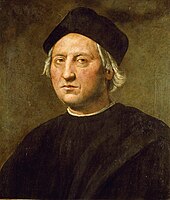


A cooling in temperatures after about 1150 saw leaner harvests across Europe and consequent shortages of food and flax material for clothing. Famines increased and in 1316 serious famine gripped Ypres. In 1410, the last of the Greenland Norseman abandoned their colony to the ice. From
The
In the
The last centuries of the Middle Ages saw the waging of the Hundred Years' War between England and France. The war began in 1337 when the king of France laid claim to English-ruled Gascony in southern France, and the king of England claimed to be the rightful king of France. At first, the English conquered half of France and seemed likely to win the war, until the French were rallied by a peasant girl, who would later become a saint, Joan of Arc. Although she was captured and executed by the English, the French fought on and won the war in 1453. After the war, France gained all of Normandy, excluding the city of Calais, which it gained in 1558.[40]
Following the Mongols from Central Asia came the
Probably the first clock in Europe was installed in a Milan church in 1335, hinting at the dawning mechanical age.
Renaissance and Reformation
The Renaissance: 14th to 17th century


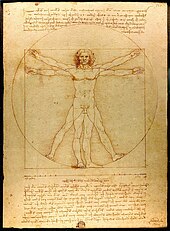

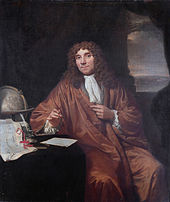
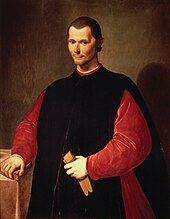
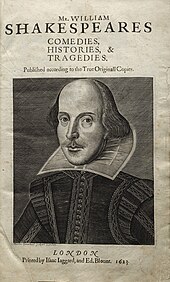
The Renaissance, originating from Italy, ushered in a new age of scientific and intellectual inquiry and appreciation of ancient Greek and Roman civilizations. The merchant cities of Florence, Genoa, Ghent, Nuremberg, Geneva, Zürich, Lisbon and Seville provided patrons of the arts and sciences and unleashed a flurry of activity.
The
Humanist historian Leonardo Bruni, split the history in the antiquity, Middle Ages and modern period.
Churches began being built in the Romanesque style for the first time in centuries. While art and architecture flourished in Italy and then the Netherlands, religious reformers flowered in Germany and Switzerland; printing was establishing itself in the Rhineland and navigators were embarking on extraordinary voyages of discovery from Portugal and Spain.[14]
Around 1450,
As the calendar reached the year 1500, Europe was blossoming – with
For the first time in European history, events North of the Alps and on the Atlantic Coast were taking centre stage.
Meanwhile, the Christian kingdoms of northern Iberia continued their centuries-long fight to
From the East, however, the Ottoman Turks under Suleiman the Magnificent continued their advance into the heart of Christian Europe — besieging Vienna in 1529.[14]
The 16th century saw the flowering of the Renaissance in the rest of the West. In the
The Reformation: 1500–1650

The other major movement in the West in the 16th century was the
In the 1540s the Frenchman
Britain and the Dutch Republic allowed Protestant dissenters to migrate to their North American colonies – thus the future United States found its early Protestant ethos – while Protestants were forbidden to migrate to the Spanish colonies (thus South America retained its Catholic hue). A more democratic organisational structure within some of the new Protestant movements – as in the Calvinists of New England – did much also to foster a democratic spirit in Britain's American colonies.[14]
The Catholic Church responded to the Reformation with the
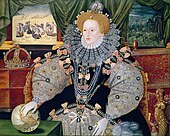
As princes, kings and emperors chose sides in religious debates and sought national unity, religious wars erupted throughout Europe, especially in the Holy Roman Empire. Emperor Charles V was able to arrange the Peace of Augsburg between the warring Catholic and Protestant nobility. However, in 1618, the Thirty Years' War began between Protestants and Catholics in the empire, which eventually involved neighboring countries like France. The devastating war finally ended in 1648. In the Peace of Westphalia ending the war, Lutheranism, Catholicism and Calvinism were all granted toleration in the empire. The two major centers of power in the empire after the war were Protestant Prussia in the north and Catholic Austria in the south. The Dutch, who were ruled by the Spanish at the time, revolted and gained independence, founding a Protestant country. The Elizabethan era is famous above all for the flourishing of English drama, led by playwrights such as William Shakespeare and for the seafaring prowess of English adventurers such as Sir Francis Drake. Her 44 years on the throne provided welcome stability and helped forge a sense of national identity. One of her first moves as queen was to support the establishment of an English Protestant church, of which she became the Supreme Governor of what was to become the Church of England.
By 1650, the religious map of Europe had been redrawn: Scandinavia, Iceland, north Germany, part of Switzerland, Netherlands and Britain were Protestant, while the rest of the West remained Catholic. A byproduct of the Reformation was increasing literacy as Protestant powers pursued an aim of educating more people to be able to read the Bible.[43]
Rise of Western empires: 1500–1800
Henry the Navigator was a key personality in European exploration in Africa and Asia.
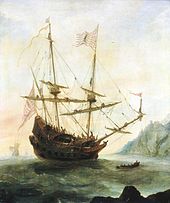 Vasco Da Gama unlocked the sea route from Europe to India (1497–1499).Küçüm , the Khan of Siberia. 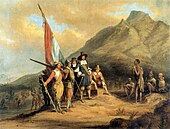 British India .From its dawn until modern times, the West had suffered invasions from Africa, Asia, and non-Western parts of Europe. By 1500 Westerners took advantage of their new technologies, sallied forth into unknown waters, expanded their power and the Age of Discovery began, with Western explorers from seafaring nations like Portugal and Castile (later Spain) and later Holland, France and England setting forth from the "Old World" to chart faraway shipping routes and discover "new worlds". In 1492, the Spanish colonization followed and Europe established Western Civilization in the Americas. The Portuguese explorer Vasco da Gama led the first sailing expedition directly from Europe to India in 1497–1499, by the Atlantic and Indian oceans, opening up the possibility of trade with the East other than via perilous overland routes like the Silk Road. Ferdinand Magellan, a Portuguese explorer working for the Spanish Crown (under the Crown of Castile), led an expedition in 1519–1522 which became the first to sail from the Atlantic Ocean into the Pacific Ocean and the first to cross the Pacific. The Spanish explorer Juan Sebastián Elcano completed the first circumnavigation of the Earth (Magellan was killed in the Philippines).
The Americas were deeply affected by European expansion, due to conquest, sickness, and introduction of new technologies and ways of life. The Spanish Other European colonial powers followed in their wake, most prominently the English, Dutch, and French. All three nations established colonies through North and South America and the West Indies. English colonies were established on Caribbean islands such as Barbados, Saint Kitts and Antigua and on North America (largely through a proprietary system) in regions such as Maryland, Massachusetts and Rhode Island. Dutch and French colonization efforts followed a similar pattern, focusing on the Caribbean and North America. The islands of Aruba, Curaçao and Sint Maarten gradually came under Dutch control, while the Dutch established the colony of New Netherland in North America. France gradually colonized Louisiana and Quebec during the 17th and 18th centuries, and transformed its West Indian colony of Saint-Domingue into the wealthiest European overseas possession in the 18th century through a slave-based plantation economy.[44] In the Americas, it seems that only the most remote peoples managed to stave off complete assimilation by Western and Western-fashioned governments. These include some of the northern peoples (i.e., Maya people are the most numerous: at around 10–11 million, 2 million, and 7 million, respectively.[45][46][47] Bolivia is the only country in the Americas with an indigenous majority.[48]
Contact between the Old and New Worlds produced the Columbian Exchange, named after Columbus. It involved the transfer of goods unique to one hemisphere to another. Westerners brought cattle, horses, and sheep to the New World, and from the New World Europeans received tobacco, potatoes, and bananas. Other items becoming important in global trade were the sugarcane and cotton crops of the Americas, and the gold and silver brought from the Americas not only to Europe but elsewhere in the Old World.
As European settlers began to colonize the Americas, numerous cash crop plantations sprung up to accommodate increasing demand in Europe. Initially, the labour source of these plantations came from European indentured servants; however, soon this system was supplemented by enslaved Africans imported by European slavers from Africa to the Americas via the transatlantic slave trade. Roughly 12 million enslaved Africans were forcibly transported to the Americas, primarily to the West Indies and South America. Once there, they were primarily forced to work on these plantations in brutal conditions, cultivating crops such as sugar, cotton and tobacco. Together with European trade to Africa and American trade to Europe, this trade was known as the "triangular trade".[49][50] Slavery continued to underpin the economies of European colonies throughout the Americas until the abolitionist movement and slave resistance led to its abolition in the 19th century.[51][52] After trading with African rulers for some time, Westerners began establishing colonies in Africa. The Portuguese conquered ports in North, West and East Africa and inland territory in what is today Catholicism. The Dutch established colonies in modern-day South Africa, which attracted many Dutch settlers. Western powers also established colonies in West Africa . However, most of the continent remained unknown to Westerners and their colonies were restricted to Africa's coasts.
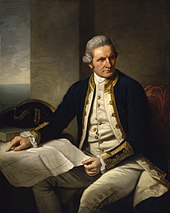 Westerners also expanded in Asia. The Portuguese controlled port cities in the East Indies, India, Persian Gulf, Sri Lanka, Southeast Asia and China. During this time, the Dutch began their colonisation of the Indonesian archipelago, which became the Dutch East Indies in the early 19th century, and gained port cities in Sri Lanka and Malaysia and India. Spain conquered the Philippines and converted the inhabitants to Catholicism. Missionaries from Iberia (including some from Italy and France) gained many converts in Japan until Christianity was outlawed by Japan's emperor. Some Chinese also became Christian, although most did not. Most of India was divided up between England and France. As Western powers expanded they competed for land and resources. In the Caribbean, Anglo-Dutch wars were fought, of which the last two were won by the Dutch. At the end of the Napoleonic Wars, England gained New Netherland (which was traded with Suriname and Dutch South Africa). In 1756, the Seven Years' War, or French and Indian War began. It involved several powers fighting on several continents. In North America, English soldiers and colonial troops defeated the French, and in India the French were also defeated by England. In Europe Prussia defeated Austria. When the war ended in 1763, New France and eastern Louisiana were ceded to England, while western Louisiana was given to Spain. France's lands in India were ceded to England. Prussia was given rule over more territory in what is today Germany.
The Dutch navigator Willem Janszoon had been the first documented Westerner to land in Australia in 1606[53][54][55] Another Dutchman, Abel Tasman later touched mainland Australia, and mapped Tasmania and New Zealand for the first time, in the 1640s. The English navigator James Cook became first to map the east coast of Australia in 1770. Cook's extraordinary seamanship greatly expanded European awareness of far shores and oceans: his first voyage reported favourably on the prospects of colonisation of Australia; his second voyage ventured almost to Antarctica (disproving long held European hopes of an undiscovered Great Southern Continent); and his third voyage explored the Pacific coasts of North America and Siberia and brought him to Hawaii, where an ill-advised return after a lengthy stay saw him clubbed to death by natives.[56] Europe's period of expansion in early modern times greatly changed the world. New crops from the Americas improved European diets. This, combined with an improved economy thanks to Europe's new network of colonies, led to a demographic revolution in the West, with infant mortality dropping, and Europeans getting married younger and having more children. The West became more sophisticated economically, adopting Mercantilism, in which companies were state-owned and colonies existed for the good of the mother country. EnlightenmentAbsolutism and the Enlightenment: 1500–1800 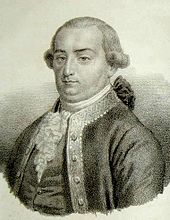  Peter I of Russia (1672–1725). Under his reign, Russia looked westward. Heavily influenced by advisors from Western Europe, he implemented sweeping reforms aimed at modernizing Russia.The West in the early modern era went through great changes as the traditional balance between monarchy, nobility and clergy shifted. With the feudal system all but gone, nobles lost their traditional source of power. Meanwhile, in Protestant countries, the church was now often headed by a monarch, while in Catholic countries, conflicts between monarchs and the Church rarely occurred and monarchs were able to wield greater power than they ever had in Western history.[citation needed] Under the doctrine of the Divine right of kings, monarchs believed they were only answerable to God: thus giving rise to absolutism. At the opening of the 15th century, tensions were still going on between Islam and Christianity. Europe, dominated by Christians, remained under threat from the Muslim Mediterranean. However, the Ottoman threat to Europe was not ended until a Polish led coalition defeated the Ottoman at the Battle of Vienna in 1683.[57][58] The Turks were driven out of Buda (the eastern part of Budapest they had occupied for a century), Belgrade, and Athens – though Athens was to be recaptured and held until 1829.[14]
The 16th century is often called Spain's After Spain began to decline in the 17th century, the Dutch, by virtue of its sailing ships, became the greatest world power, leading the 17th century to be called the corporate colonialism model of the East India and West India Companies. After the Anglo-Dutch Wars, France and England emerged as the two greatest powers in the 18th century.[60]
 universal gravitation and the laws of motion .Versailles .
The Habsburg dynasty, Austria became a great empire, expanding at the expense of the Ottoman Empire and Hungary.
One land where absolutism did not take hold was England, which had trouble with revolutionaries. Puritan Oliver Cromwell as Lord Protector. Cromwell enacted many unpopular Puritan religious laws in England, like outlawing alcohol and theaters, although religious diversity may have grown. (It was Cromwell, after all, that invited the Jews back into England after the Edict of Expulsion.) After his death, the monarchy was restored under Charles's son, who was crowned Charles II. His son, James II succeeded him. James and his infant son were Catholics.
Not wanting to be ruled by a Catholic dynasty, Parliament invited James's daughter Act of Union of 1707 were passed by the parliaments of Scotland and England, merging Scotland and England into a single Kingdom of Great Britain, with a single parliament. This new kingdom also controlled Ireland which had previously been conquered by England. Following the Irish Rebellion of 1798, in 1801 Ireland was formally merged with Great Britain to form the United Kingdom of Great Britain and Ireland. Ruled by the Protestant Ascendancy, Ireland eventually became an English-speaking land, though the majority population preserved distinct cultural and religious outlooks, remaining predomininantly Catholic except in parts of Ulster and Dublin. By then, the British experience had already contributed to the American Revolution .
 Warsaw's Royal Castle , where it has just been adopted.The Komisja Edukacji Narodowej, Polish for Commission of National Education, formed in 1773, was the world's first national Ministry of Education and an important achievement of the Polish Enlightenment.[62]
The intellectual movement called the Age of Enlightenment began in this period as well. Its proponents opposed the absolute rule of the monarchs, and instead emphasized the equality of all individuals and the idea that governments should derive their existence from the consent of the governed. Enlightenment thinkers called philosophes (French for philosophers) idealized Europe's classical heritage. They looked at Athenian democracy and the Roman Republic as ideal governments. They believed reason held the key to creating an ideal society.[63]  The Englishman Francis Bacon espoused the idea that senses should be the primary means of knowing, while the Frenchman René Descartes advocated using reason over the senses. In his works, Descartes was concerned with using reason to prove his own existence and the existence of the external world, including God. Another belief system became popular among philosophes, Deism, which taught that a single god had created but did not interfere with the world. This belief system never gained popular support and largely died out by the early 19th century. Second Treatise of Government (1689)) and Rousseau (Du contrat social (1762) ). Social contract arguments examine the appropriate relationship between government and the governed and posit that individuals unite into political societies by a process of mutual consent, agreeing to abide by common rules and accept corresponding duties to protect themselves and one another from violence and other kinds of harm.
In 1690 John Locke wrote that people have certain enlightened despots. However, most only supported Enlightenment ideas that strengthened their own power.[citation needed ]
The Scottish Enlightenment was a period in 18th century Scotland characterised by an outpouring of intellectual and scientific accomplishments. Scotland reaped the benefits of establishing Europe's first public education system and a growth in trade which followed the Act of Union with England of 1707 and expansion of the British Empire. Important modern attitudes towards the relationship between science and religion were developed by the philosopher/historian David Hume. Adam Smith developed and published The Wealth of Nations, the first work in modern economics. He believed competition and private enterprise could increase the common good. The celebrated bard Robert Burns is still widely regarded as the national poet of Scotland. European cities like Paris, London, and Vienna grew into large metropolises in early modern times. France became the cultural center of the West. The middle class grew even more influential and wealthy. Great artists of this period included El Greco, Rembrandt, and Caravaggio. By this time, many around the world wondered how the West had become so advanced, for example, the Orthodox Christian Russians, who came to power after conquering the Mongols that had conquered Kiev in the Middle Ages. They began westernizing under Czar Peter the Great, although Russia remained uniquely part of its own civilization. The Russians became involved in European politics, dividing up the Polish–Lithuanian Commonwealth with Prussia and Austria. Revolution: 1770–1815U.S. Constitution 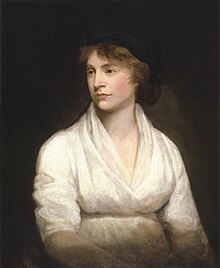 During the late 18th century and early 19th century, much of the West experienced a series of Society of Friends and the Lutherans, as well as some Roman Catholics and Jews. The colonies had their own great cities and universities and continually welcomed new immigrants, mostly from Britain. After the expensive Seven Years' War , Britain needed to raise revenue, and felt the colonists should bare the brunt of the new taxation it felt was necessary. The colonists greatly resented these taxes and protested the fact they could be taxed by Britain but had no representation in the government.
After Britain's King George III refused to seriously consider colonial grievances raised at the first Continental Congress, some colonists took up arms. Leaders of a new pro-independence movement were influenced by Enlightenment ideals and hoped to bring an ideal nation into existence. On 4 July 1776, the colonies declared independence with the signing of the United States Declaration of Independence. Drafted primarily by Thomas Jefferson , the document's preamble eloquently outlines the principles of governance that would come to increasingly dominate Western thinking over the ensuing century and a half:
The United States of America .
The other major Western revolution at the turn of the 19th century was the Estates General, an assembly of representatives of each estate of the kingdom: the First Estate (the clergy), the Second Estate (the nobility), and the Third Estate (middle class and peasants); in order to deal with the crisis. As the French society was gained by the same Enlightenment ideals that led to the American revolution, in which many Frenchmen, such as Lafayette, took part; representatives of the Third Estate, joined by some representatives of the lower clergy, created the National Assembly , which, unlike the Estates General, provided the common people of France with a voice proportionate to their numbers.
The people of Paris feared the King would try to stop the work of the National Assembly and Paris was soon consumed with riots, anarchy, and widespread looting. The mobs soon had the support of the French Guard, including arms and trained soldiers, because the royal leadership essentially abandoned the city. On the fourteenth of July 1789 a mob stormed the Bastille, a prison fortress, which led the King to accept the changes. On 4 August 1789 the National Constituent Assembly abolished feudalism sweeping away both the seigneurial rights of the Second Estate and the tithes gathered by the First Estate. It was the first time in Europe, where feudalism was the norm for centuries, that such a thing happened. In the course of a few hours, nobles, clergy, towns, provinces, companies, and cities lost their special privileges. At first, the revolution seemed to be turning France into a Napoleon Bonaparte seized power as dictator and even an emperor in 1804.
Liberté, égalité, fraternité (French for "Liberty, equality, fraternity"),[65] now the national motto of France, had its origins during the French Revolution, though it was only later institutionalised. It remains another iconic motto of the aspirations of Western governance in the modern world. Some influential intellectuals came to reject the excesses of the revolutionary movement. Political theorist The Rights of Man in 1791 as a defence of the ideals of the French Revolution. The spirit of the age also produced early works of feminist philosophy – notably Mary Wollstonecraft's 1792 book: A Vindication of the Rights of Woman .
Napoleonic Wars The world power for the next century,[66] thus beginning Pax Britannica .
France had to fight on multiple battlefronts against the other European powers. A nationwide conscription was voted to reinforce the old royal army made of noble officers and professional soldiers. With this new kind of army, Napoleon was able to beat the European allies and dominate Europe. The revolutionary ideals, based no more on feudalism but on the concept of a sovereign nation, spread all over Europe. When Napoleon eventually lost and the monarchy reinstated in France, these ideals survived and led to the revolutionary waves of the 19th century that brought democracy to many European countries.[67][68] With the success of the American Revolution, the loyalists, the Spanish American Independence Wars immediately ensued; resulting, by the 1820s, in the definitive loss for the Spanish Empire of all its American territories, with the exception of Cuba and Puerto Rico.[69]
Rise of the English-speaking world: 1815–1870 The years following Britain's victory in the Napoleonic Wars were a period of expansion for Britain as it rebuilt the British Empire. The new United States grew even more rapidly. This period of expansion would help establish Anglicanism as the dominant religion, English as the dominant language, and English and Anglo-American culture as the dominant culture of two continents and many other lands outside the British Isles. Industrial Revolution in the English-speaking world Rapid economic growth following the Napoleonic Wars was the continuing product of the ever-expanding factories. This resulted in great societal changes, and many people settled in the cities where the factories were located. Factory work could often be brutal.[70]
With no safety regulations, people became sick from contaminants in the air in corporations, were run by individual investors.[71]
New ideological movements began as a result of the Industrial Revolution, including the Unions were founded among industrial workers to help secure better wages and rights. Another result of the revolution was a change in societal hierarchy, especially in Europe, where nobility still occupied a high level on the social ladder. Capitalists emerged as a new powerful group, with educated professionals like doctors and lawyers under them, and the various industrial workers at the bottom. These changes were often slow however, with Western society as a whole remaining primarily agricultural for decades.[72]
Great Britain: 1815–1870 From 1837 until 1901, Queen Victoria reigned over Great Britain and the ever-expanding British Empire. The Industrial Revolution accelerated, making Britain the most powerful nation. It enjoyed relative peace and stability from 1815 until 1914, this period is often called the Pax Britannica, from the Latin "British Peace". The monarch became more a figurehead and symbol of national identity; actual power was in the hands of the prime minister and the cabinet, and was based on a majority in the House of Commons. Two rival parties were the Conservative Party and the Liberal Party. The Liberal constituency was made up mostly of businessmen, as many Liberals supported the idea of a free market. Conservatives were supported by the aristocracy and gentry landowners. Control of Parliament switched back and forth between the parties. Overall, it was a period of reform.[73]
In 1832 more representation was granted to new industrial cities, and laws barring Catholics from serving in Parliament were repealed, although discrimination against Catholics, especially Irish Catholics, continued. Other reforms granted near universal manhood suffrage, and state-supported elementary education for all Britons. More rights were granted to workers as well. Ireland had been ruled from London since the Middle Ages. After the Protestant Reformation the British Establishment began a campaign of discrimination against Roman Catholic and Act of Union of 1800 was passed, creating the United Kingdom of Great Britain and Ireland. In the mid-19th century, Ireland suffered a devastating famine, which killed 10% of the population[74] and led to massive emigration: see Irish diaspora .
British Empire: 1815–1870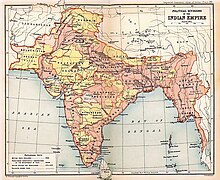 Throughout the 19th century, Britain's power grew enormously and the sun quite literally "never set" on the British Empire, for it had outposts on every occupied continent. It consolidated control over such far flung territories as Canada and Jamaica in the Americas, Australia and New Zealand in Oceania; Malaya, Hong Kong and Singapore in the Far East and a line of colonial possessions from Egypt to the Cape of Good Hope through Africa.[75] All of India was under British rule by 1858.[76] In 1804, the Shah of the declining Burma. Among the British born in India were the immensely influential writers Rudyard Kipling (1865) and George Orwell (1903).[77]
In the Far East, Britain went to war with the declining Qing dynasty of China when it tried to stop British merchants in China from selling the opium to the Chinese public. The First Opium War (1840–1842), ended in a British victory, and China was forced to remove barriers to British trade and cede several ports and the island of Hong Kong to Britain. Soon, other powers sought these same privileges with China and China was forced to agree, ending Chinese isolation from the rest of the world. In 1853 an American expedition opened up Japan to trade with first the U.S., and then the rest of the world. In 1833, Britain ended slavery by buying out all the owners throughout its empire after a successful campaign by abolitionists. Furthermore, Britain had a great deal of success attempting to get other powers to outlaw the practice as well. As British settlement of southern Africa continued, the descendants of the Dutch in southern Africa, called the Boers or Afrikaners, whom Britain had ruled since the Anglo-Dutch Wars, migrated northward, disliking British rule. Explorers and missionaries like David Livingstone became national heroes. Cecil Rhodes founded Rhodesia and a British army under Lord Kitchener secured control of Sudan in the 1898 Battle of Omdurman. Canada: 1815–1870 Following the American Revolution, many Loyalists to Britain fled north to what is today Canada (where they were called United Empire Loyalists). Joined by mostly British colonists, they helped establish early colonies like Ontario and New Brunswick. British settlement in North America increased, and soon there were several colonies both north and west of the early ones in the northeast of the continent, these new ones included British Columbia and Prince Edward Island.[78] Rebellions broke out against British rule in 1837, but Britain appeased the rebels' supporters in 1867 by confederating the colonies into Canada, with its own prime minister. Although Canada was still firmly within the British Empire, its people now enjoyed a great degree of self-rule. Canada was unique in the British Empire in that it had a French-speaking province, Quebec, which Britain had gained rule over in the Seven Years' War.[79] Australia and New Zealand: 1815–1870 The New South Wales, Australia in 1788 and established a British outpost and penal colony at Sydney Cove.[80] These convicts were often petty 'criminals', and represented the population spill-over of Britain's Industrial Revolution, as a result of the rapid urbanisation and dire crowding of British cities. Other convicts were political dissidents, particularly from Ireland. The establishment of a wool industry and the enlightened governorship of Lachlan Macquarie were instrumental in transforming New South Wales from a notorious prison outpost into a budding civil society. Further colonies were established around the perimeter of the continent and European explorers ventured deep inland. A free colony was established at South Australia in 1836 with a vision for a province of the British Empire with political and religious freedoms. The colony became a cradle of democratic reform. The Australian gold rushes increased prosperity and cultural diversity and autonomous democratic parliaments began to be established from the 1850s onward.[81]
The native inhabitants of Australia, called the immunity .
From the early 19th century, New Zealand was being visited by European explorers, sailors, missionaries, traders and adventurers (known as Pākehā) and was administered by Britain from the nearby colony of New South Wales. In 1840 Britain signed the Treaty of Waitangi with the natives of New Zealand, the Māori, in which Britain gained sovereignty over the archipelago. As more European settlers arrived, clashes resulted and the New Zealand colonial government fought several wars before defeating the Māori. By 1870, New Zealand had a population made up mostly of European descent.[82] United States: 1815–1870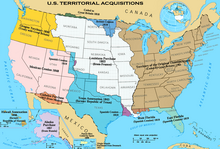  Following independence from Britain, the United States began expanding westward, and soon a number of new states had joined the union. In 1803, the United States purchased the Napoleon I, had regained it from Spain. Soon, America's growing population was settling the Louisiana Territory, which geographically doubled the size of the country. At the same time, a series of revolutions and independence movements in Spain and Portugal's American empires resulted in the liberation of nearly all of Latin America, as the region composed of South America, most of the Caribbean, and North America from Mexico south became known. At first Spain and its allies seemed ready to try to reconquer the colonies, but the U.S. and Britain opposed this, and the reconquest never took place. From 1821 on, the U.S. bordered the newly independent nation of Mexico. An early problem faced by the Mexican republic was what to do with its sparsely populated northern territories, which today make up a large part of the American West. The government decided to try to attract Americans looking for land. Americans arrived in such large numbers that both the provinces of Texas and California had majority white , English-speaking populations.
This led to a culture clash between these provinces and the rest of Mexico. When Mexico became a dictatorship under General Antonio López de Santa Anna, the Texans declared independence. After several battles, Texas gained independence from Mexico, although Mexico later claimed it still had a right to Texas. After existing as a republic modeled after the U.S. for several years, Texas joined the United States in 1845. This led to border disputes between the U.S. and Mexico, resulting in the Mexican–American War. The war ended with an American victory, and Mexico had to cede all its northern territories to the United States, and recognize the independence of California, which had revolted against Mexico during the war. In 1850, California joined the United States. In 1848, the U.S. and Britain resolved a border dispute over territory on the Pacific coast, called the Oregon Country by giving Britain the northern part and the U.S. the southern part. In 1867, the U.S. expanded again, purchasing the Russian colony of Alaska, in northwestern North America.[83] Politically, the U.S. became more democratic with the abolishment of property requirements in voting, although voting remained restricted to white males. By the mid-19th century, the most important issue was slavery. The free states. In 1860, the anti-slavery candidate Abraham Lincoln was elected president. Fearing he would try to outlaw slavery in the whole country, several southern states seceded, forming the Confederate States of America, electing their own president and raising their own army. Lincoln countered that secession was illegal and raised an army to crush the rebel government, thus the advent of the American Civil War (1861–65).
The Republican Party, which outlawed slavery, granted blacks equality and black males voting rights via constitutional amendments. However, although the abolishment of slavery would not be challenged, equal treatment for blacks would be.[84]
The United States history, was delivered at the dedication of the Soldiers' National Cemetery in Gettysburg, Pennsylvania on 19 November 1863, during the Civil War, four and a half months after the Battle of Gettysburg . Describing America as a "nation conceived in Liberty and dedicated to the proposition that all men are created equal", Lincoln famously called on those gathered:
Continental Europe: 1815–1870Duke of Wellington at the Battle of Waterloo, the battle which brought an end to the Napoleonic Wars The years following the Napoleonic Wars were a time of change in Europe. The Industrial Revolution, nationalism, and several political revolutions transformed the continent.[67] Industrial technology was imported from Britain. The first lands affected by this were France, the Low Countries, and western Germany. Eventually the Industrial Revolution spread to other parts of Europe. Many people in the countryside migrated to major cities like Paris, Berlin, and Amsterdam, which were connected like never before by railroads. Europe soon had its own class of wealthy industrialists, and large numbers of industrial workers. New ideologies emerged as a reaction against perceived abuses of industrial society. Among these ideologies were socialism and the more radical communism, created by the German Karl Marx. According to communism, history was a series of class struggles, and at the time industrial workers were pitted against their employers. Inevitably the workers would rise up in a worldwide revolution and abolish private property, according to Marx. Communism was also atheistic, since, according to Marx, religion was simply a tool used by the dominant class to keep the oppressed class docile. colonial decline and the Liberal Wars .Several revolutions occurred in Europe following the Napoleonic Wars. The goal of most of these revolutions was to establish some form of democracy in a particular nation. Many were successful for a time, but their effects were often eventually reversed. Examples of this occurred in Spain, Italy, and Austria. Several European nations stood steadfastly against revolution and democracy, including Austria and Russia. Two successful revolts of the era were the Greek and Serbian wars of independence, which freed those nations from Ottoman rule. Another successful revolution occurred in the Low Countries. After the Napoleonic Wars, the Netherlands was given control of modern-day Belgium, which had been part of the Holy Roman Empire. The Dutch found it hard to rule the Belgians, due to their Catholic religion and French language. In the 1830s, the Belgians successfully overthrew Dutch rule, establishing the Kingdom of Belgium.[85] In 1848 a series of revolutions occurred in Prussia, Austria, and France. In France, the king, Napoleon I was elected the republic's first president. Extremely popular, Napoleon was made Napoleon III (since Napoleon I's son had been crowned Napoleon II during his reign), Emperor of the French, by a vote of the French people, ending France's Second Republic . Revolutionaries in Prussia and Italy focused more on nationalism, and most advocated the establishment of unified German and Italian states, respectively.
Risorgimento saw Italy unite as one kingdom .In the Unification of the peninsula began in 1859.
The powerful Garibaldi led revolutionaries in an overthrow of the government of the Kingdom of the Two Sicilies. A plebiscite held there resulted in a unification of that kingdom with Italy. Italian forces seized the eastern Papal States in 1861.
In 1866 Venetia became part of Italy after Italy's ally, Prussia, defeated that kingdom's rulers, the Austrians, in the Austro-Prussian War. In 1870, Italian troops conquered the Papal States, completing unification. Pope Pius IX refused to recognize the Italian government or negotiate settlement for the loss of Church land.
Prussia in the middle and late parts of the 19th century was ruled by its king, Wilhelm I, and its skilled chancellor, Otto von Bismarck. In 1864, Prussia went to war with Denmark and gained several German-speaking lands as a result. In 1866, Prussia went to war with the Austrian Empire and won, and created a confederation of it and several German states, called the North German Confederation, setting the stage for the 1871 formation of the German Empire .
After years of dealing with Hungarian revolutionaries, whose kingdom Austria had conquered centuries earlier, the Austrian emperor, Austro-Hungarian Empire was created in 1867. The two peoples were united in loyalty to the monarch and Catholicism.
There were changes throughout the West in science, religion and culture between 1815 and 1870. Europe in 1870 differed greatly from its state in 1815. Most Western European nations had some degree of democracy, and two new national states had been created, Italy and Germany. Political parties were formed throughout the continent and with the spread of industrialism, Europe's economy was transformed, although it remained very agricultural. Culture, arts and sciences: 1815–1914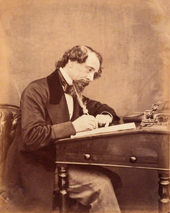  Pyotr Tchaikovsky .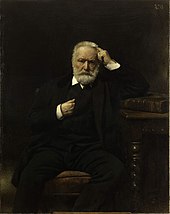 radioactivity . The 19th and early 20th centuries saw important contributions to the process of modernisation of Western art and Literature and the continuing evolution in the role of religion in Western societies.
Napoleon re-established the Catholic Church in France through the LDS Churches were founded. Many Westerners became less religious in this period, although a majority of people still held traditional Christian beliefs.
The 1859 publication of In 1869 Russian chemist radioactivity .
In Europe by the 19th century, fashion had shifted away from such artistic styles as Just as Mannerism rejected Classicism, so did Victorian Era with leading exponents including William Wordsworth, Samuel Taylor Coleridge, Robert Burns, Edgar Allan Poe and John Keats. Other Romantic writers included Sir Walter Scott, Lord Byron, Alexander Pushkin, Victor Hugo, and Goethe .
Some of the best regarded poets of the era were women. feminist philosophy, A Vindication of the Rights of Woman which called for equal education for women in 1792 and her daughter, Mary Shelley became an accomplished author best known for her 1818 novel Frankenstein , which examined some of the frightening potential of the rapid advances of science.
In early 19th-century Europe, in response to Jean-Baptiste-Siméon Chardin, Gustave Courbet, Jean-François Millet, Camille Corot, Honoré Daumier, Édouard Manet, Edgar Degas (both considered as Impressionists), Ilya Repin, and Thomas Eakins , among others.
Writers also sought to come to terms with the new industrial age. The works of the Englishman William Butler Yeats prefigured the emergence of the 20th-century Irish literary giants James Joyce, Samuel Beckett and Patrick Kavanagh. In Britain's Australian colonies, bush balladeers such as Henry Lawson and Banjo Paterson brought the character of a new continent to the pages of world literature.
The response of architecture to industrialisation, in stark contrast to the other arts, was to veer towards historicism. The railway stations built during this period are often called "the cathedrals of the age". Architecture during the Industrial Age witnessed revivals of styles from the distant past, such as the Notre Dame de Paris Cathedral in Paris was also restored in the Gothic style, following its desecration during the French Revolution .
Out of the naturalist ethic of Realism grew a major artistic movement, Impressionism. The Impressionists pioneered the use of light in painting as they attempted to capture light as seen from the human eye. Edgar Degas, Édouard Manet, Claude Monet, Camille Pissarro, and Pierre-Auguste Renoir, were all involved in the Impressionist movement. As a direct outgrowth of Impressionism came the development of Post-Impressionism. Paul Cézanne, Vincent van Gogh, Paul Gauguin, Georges Seurat are the best known Post-Impressionists. In Australia the Heidelberg School was expressing the light and colour of Australian landscape with a new insight and vigour. The Ping Pong,[90][91] modern tennis,[92] Association football, netball and rugby. The United States also developed popular international sports during this period. English migrants took antecedents of baseball to America during the colonial period. American football resulted from several major divergences from rugby, most notably the rule changes instituted by Walter Camp. Basketball was invented in 1891 by James Naismith, a Canadian physical education instructor working in Springfield, Massachusetts in the United States. Baron Pierre de Coubertin, a Frenchman, instigated the modern revival of the Olympic Games, with the first modern Olympics being held in Athens in 1896.[93]
New Imperialism: 1870–1914The years between 1870 and 1914 saw the expansion of Western power. By 1914, the Western and some Asian and Eurasian empires like the Qing China dominated the entire planet. The major Western players in this New Imperialism were the United Kingdom, Russia, France, Germany, Italy, the Netherlands, Spain, Portugal, Belgium, Denmark, Sweden-Norway, and the United States. Japan was the only non-Western power involved in this new era of imperialism .
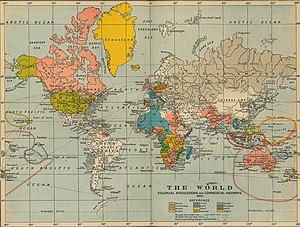 Although the West had had a presence in Africa for centuries, its colonies were limited mostly to Africa's coast. Europeans, including the Britons Mungo Park and David Livingstone, the German Johannes Rebmann, and the Frenchman René Caillié, explored the interior of the continent, allowing greater European expansion in the later 19th century. The period between 1870 and 1914 is often called the Scramble for Africa, due to the competition between European nations for control of Africa. In 1830, France occupied Algeria in North Africa. Many Frenchman settled on Algeria's Mediterranean coast. In 1882 Britain annexed Egypt. France eventually conquered most of Morocco and Tunisia as well. Libya was conquered by the Italians. Spain gained a small part of Morocco and modern-day Western Sahara. West Africa was dominated by France, although Britain ruled several smaller West African colonies. Germany also established two colonies in West Africa, and Portugal had one as well. Central Africa was dominated by the Belgian Congo. At first the colony was ruled by Belgium's king, Leopold II, however his regime was so brutal the Belgian government took over the colony. The Germans and French also established colonies in Central Africa. The British and Italians were the two dominant powers in East Africa, although France also had a colony there. Boer Wars, fought on and off between the 1880s and 1902, ending in a British victory. In 1910 Britain united its South African colonies with the former Boer republics and established the Union of South Africa, a dominion of the British Empire. The British established several other colonies in Southern Africa. The Portuguese and Germans also established a presence in Southern Africa. The French conquered the island of Madagascar .
By 1914, Africa had only two independent nations, rubber, diamond and gold industries on the continent. Perhaps the most ambitious change by Europeans was the construction of the Suez Canal in Egypt, allowing ships to travel from the Atlantic to the Indian Ocean without having to go all the way around Africa.
In Asia, China was defeated by Britain in the First Opium War and later Britain and France in the Persia. Britain, however, established a sphere of influence in Persia and a few small colonies in Arabia and coastal Mesopotamia .
The Pacific islands were conquered by Germany, the U.S., Britain, France, and Belgium. In 1893, the ruling class of colonists in Hawaii overthrew the Hawaiian monarchy of Queen Liliuokalani and established a republic. Since most of the leaders of the overthrow were Americans or descendants of Americans, they asked to be annexed by the United States, which agreed to the annexation in 1898.
Latin America was largely free from foreign rule throughout this period, although the United States and Britain had a great deal of influence over the region. Britain had two colonies on the Latin American mainland, while the United States, following 1898, had several in the Caribbean. The U.S. supported the independence of Cuba and Panama, but gained a small territory in central Panama and intervened in Cuba several times. Other countries also faced American interventions from time to time, mostly in the Caribbean and southern North America. Competition over control of overseas colonies sometimes led to war between Western powers, and between Western powers and non-Westerners. At the turn of the 20th century, Britain fought several wars with Afghanistan to prevent it from falling under the influence of Russia, which ruled all of Central Asia excluding Afghanistan. Britain and France nearly went to war over control of Africa. In 1898, the United States and Spain went to war after an American naval ship was sunk in the Caribbean. Although today it is generally held that the sinking was an accident, at the time the U.S. held Spain responsible and soon American and Spanish forces clashed everywhere from Cuba to the Philippines. The U.S. won the war and gained several Caribbean colonies including Puerto Rico and several Pacific islands, including Guam and the Philippines. Important resistance movements to Western Imperialism included the Boxer Rebellion, fought against the colonial powers in China, and the Philippine–American War, fought against the United States, both of which failed. The nationalisms hatched under Ottoman rule, contributed to the development of Islamism .
The expanding Western powers greatly changed the societies they conquered. Many connected their empires via railroad and telegraph and constructed churches, schools, and factories. Great powers and the First World War: 1870–1918 By the late 19th century, the world was dominated by a few great powers , including Great Britain, the United States, and Germany. France, Russia, Austria-Hungary, and Italy were also great powers.
Western inventors and industrialists transformed the West in the late 19th century and early 20th century. The American skyscrapers .
In the late 19th century, the Italian child labor had been passed in many Western countries.
Culturally, the English-speaking nations were in the midst of the Victorian era, named for Britain's queen. In France, this period is called the Belle Époque, a period of many artistic and cultural achievements. The suffragette movement began in this period, which sought to gain voting rights for women, with New Zealand and Australian parliaments granting women's suffrage in the 1890s. However, by 1914, only a dozen U.S. states had given women this right, although women were treated more and more as equals of men before the law in many countries. Cities grew as never before between 1870 and 1914.[98] This led at first to unsanitary and crowded living conditions, especially for the poor. However, by 1914, municipal governments were providing police and fire departments and garbage removal services to their citizens, leading to a drop in death rates. Unfortunately, pollution from burning coal and wastes left by thousands of horses that crowded the streets worsened the quality of life in many urban areas. Paris, lit up by gas and electric light, and containing the tallest structure in the world at the time, the Eiffel Tower, was often looked to as an ideal modern city, and served as a model for city planners around the world. United States: 1870–1914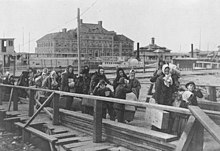 Following the Reconstruction as this period was called, came to an end. After being re-admitted to the Union, Southern lawmakers passed segregation laws and laws preventing blacks from voting, resulting in blacks being regarded as second-class citizens for decades to come.[99]
Another great change beginning in the 1870s was the settlement of the western territories by Americans. America's population greatly increased between 1870 and 1914, due largely to immigration. The U.S. became a major military and industrial power during this time, gaining a colonial empire from Spain and surpassing Britain and Germany to become the world's major industrial power by 1900. Despite this, most Americans were reluctant to get involved in world affairs, and American presidents generally tried to keep the U.S. out of foreign entanglement. Europe: 1870–1914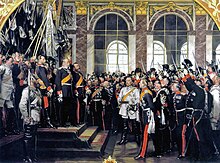 The years between 1870 and 1914 saw the rise of Germany as the dominant power in Europe. By the late 19th century, Germany had surpassed Britain to become the world's greatest industrial power. It also had the mightiest army in Europe.[102] From 1870 to 1871, Prussia was at war with France. Prussia won the war and gained two border territories, Alsace and Lorraine, from France. After the war, Wilhelm took the title kaiser from the Roman title caesar, proclaimed the German Empire, and all the German states other than Austria united with this new nation, under the leadership of Prussian Chancellor Otto von Bismarck. After the Franco-Prussian War, Napoleon III was dethroned and France was proclaimed a republic. During this time, France was increasingly divided between Catholics and monarchists and anticlerical and republican forces. In 1900, church and state were officially separated in France, although the majority of the population remained Catholic. France also found itself weakened industrially following its war with Prussia due to its loss of iron and coal mines following the war. In addition, France's population was smaller than Germany's and was hardly growing. Despite all this, France's strong sense of nationhood, among other things, kept the country together. Between 1870 and 1914, Britain continued to peacefully switch between Liberal and Conservative governments, and maintained its vast empire, the largest in world history. Two problems faced by Britain in this period were the resentment of British rule in Ireland and Britain's falling behind Germany and the United States in industrial production. British dominions: 1870–1914The European populations of Canada, Australia, New Zealand and South Africa all continued to grow and thrive in this period and evolved democratic Westminster system parliaments. Canada united as a 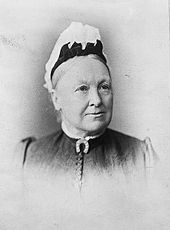 From the 1850s, Canada, Australia and New Zealand had become laboratories of democracy. By the 1870s, they had already granted voting rights to their citizens in advance of most other Western nations. In 1893, New Zealand became the first self-governing nation to extend the right to vote to women and, in 1895, the women of South Australia also became the first to obtain the right to stand for Parliament. During the 1890s Australia also saw such milestones as the invention of the Social Democratic governments in Europe. The old age pension was established in Australia and New Zealand by 1900.[14]
From the 1880s, the antipodean artists such as the opera singer Dame Nellie Melba began to influence the European arts.
Rival alliances Neutral The late 19th century saw the creation of two rival alliances in Europe. Germany, Italy, and Austria-Hungary formed the Balkan Peninsula. This Russian policy, called Pan-Slavism, led to conflicts with the Ottoman and Austro-Hungarian Empires, which had many Slavic subjects. Franco-German relations were also tense in this period due to France's defeat and loss of land at the hands of Prussia in the Franco-Prussian War. Also in this period, Britain ended its policy of isolation from the European continent and formed an alliance with France, called the Entente Cordiale . Rather than achieve greater security for the nations of Europe, however, these alliances increased the chances of a general European war breaking out.
Other factors that would eventually lead to World War I were the competition for overseas colonies, the military buildups of the period, most notably Germany's, and the feeling of intense nationalism throughout the continent. World War I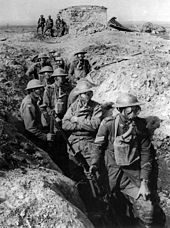 When the war broke out, much of the fighting was between Western powers, and the immediate To reach France, Germany invaded neutral Belgium in August, leading Britain to declare war on Germany. The war quickly stalemated, with chemical weapons were used at one point. The war also involved other nations, with Romania and Greece joining the British Empire and France and Bulgaria and the Ottoman Empire joining Germany. The war spread throughout the globe with colonial armies clashing in Africa and Pacific nations such as Japan and Australia, allied with Britain, attacking German colonies in the Pacific.
In the Middle East, the Arab revolt and conquered Mesopotamia and Palestine from the Ottomans with the support of local Arab rebels. The British Empire also supported an Arab revolt against the Ottomans that was centered in the Arabian Peninsula .
1916 saw some of the most ferocious fighting in human history with the Somme Offensive on the Western Front alone resulting in 500,000 German casualties, 420,000 British and Dominion casualties, and 200,000 French casualties.[107]
1917 was a crucial year in the war. The United States had followed a policy of neutrality in the war, feeling it was a European conflict. However, during the course of the war many Americans had died on board British ocean liners sunk by the Germans, leading to anti-German feelings in the U.S. There had also been incidents of sabotage on American soil, including the Black Tom explosion. What finally led to American involvement in the war, however, was the discovery of the Zimmermann Telegram, in which Germany offered to help Mexico conquer part of the United States if it formed an alliance with Germany. In April, the U.S. declared war on Germany. The same year the U.S. entered the war, Russia withdrew. After the deaths of many Russian soldiers and hunger in Russia, a revolution occurred against the Czar, Nicholas II. Nicholas abdicated and a Liberal provisional government was set up. In October, Russian communists, led by Vladimir Lenin rose up against the government, resulting in a civil war. Eventually, the communists won and Lenin became premier. Feeling World War I was a capitalist conflict, Lenin signed a peace treaty with Germany in which it gave up a great deal of its Central and Eastern European lands. 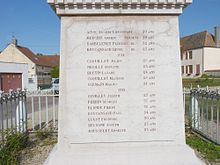 Although Germany and its allies no longer had to focus on Russia, the large numbers of American troops and weapons reaching Europe turned the tide against Germany, and after more than a year of fighting, Germany surrendered. The treaties which ended the war, including the famous Atatürk and the Ottoman homeland of Turkey was declared a republic. Germany's kaiser also abdicated and Germany was declared a republic. Germany was also forced to give up the lands it had gained in the Franco-Prussian War to France, accept responsibility for the war, reduce its military and pay reparations to Britain and France.
In the Middle East, Britain gained Palestine, Transjordan (modern-day Jordan), and Mesopotamia as colonies. France gained Syria and Lebanon. An independent kingdom consisting of most of the Arabian peninsula, Saudi Arabia, was also established. Germany's colonies in Africa, Asia, and the Pacific were divided between the British and French Empires. The war had cost millions of lives and led many in the West to develop a strong distaste for war. Few were satisfied with, and many despised the agreements made at the end of the war. Japanese and Italians were angry that they had not been given any new colonies after the war, and many Americans felt the war had been a mistake. Germans were outraged at the state of their country following the war. Also, unlike many in the United States had hoped for, democracy did not flourish in the world in the post-war period. The League of Nations, an international organization proposed by American president Woodrow Wilson to prevent another great war from breaking out, proved ineffective, especially because the United States Senate stopped Wilson White House from ratifying U.S. membership.[108]
Interwar years: 1918–1939United States in the interwar years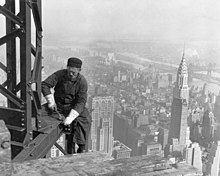 After World War I, most Americans regretted getting involved in world affairs and desired a "return to normalcy". The 1920s were a period of economic prosperity in the United States. Many Americans bought cars, radios, and other appliances with the help of installment payments. Also, many Americans invested in the stock market as a source of income. Movie theaters sprang up throughout the country, although at first they did not have sound. Alcoholic beverages were outlawed in the United States and women were granted the right to vote. Although the United States was arguably the most powerful nation in the post-war period, Americans remained isolationist and elected several conservative presidents during this period. In October 1929 the series of policies which regulated the stock market and banks, and created many public works programs aimed at providing the unemployed with work. Roosevelt's policies helped alleviate the worst effects of the Depression, although by 1941 the Great Depression was still ongoing. Roosevelt also instituted pensions for the elderly and provided money to those who were unemployed. Roosevelt was also one of the most popular presidents in U.S. history, earning re-election in 1936, and also in 1940 and 1944, becoming the only U.S. president to serve more than two terms.
Europe in the interwar yearsterritorial changes in Europe after World War I (as of 1923)Europe was relatively unstable following World War I. Although many prospered in the 1920s, Germany was in a deep financial and economic crisis. Also, France and Britain owed the U.S. a great deal of money. When the United States went into Depression, so did Europe. There were perhaps 30 million people around the world unemployed following the Depression. Many governments helped to alleviate the suffering of their citizens and by 1937 the economy had improved although the lingering effects of the Depression remained. Also, the Depression led to the spread of radical left-wing and right-wing ideologies, like Communism and Fascism. In 1919-1921 Peace of Riga, was signed on 18 March 1921. According to the British historian A. J. P. Taylor, the Polish–Soviet War "largely determined the course of European history for the next twenty years or more. [...] Unavowedly and almost unconsciously, Soviet leaders abandoned the cause of international revolution."[109] It would be twenty years before the Bolsheviks would send their armies abroad to 'make revolution'. According to American sociologist Alexander Gella, "the Polish victory had gained twenty years of independence not only for Poland, but at least for an entire central part of Europe."[citation needed ]
In 1916, militant Irish republicans staged a United Kingdom of Great Britain and Northern Ireland .
In 1918, the UK granted the right to vote to women.[110] British dominions in the interwar yearsNewfoundland), Coates (New Zealand), Bruce (Australia), Hertzog (South Africa), Cosgrave (Irish Free State), King (Canada ).The relationship between Britain and its Empire evolved significantly over the period. In 1919, the British Empire was represented at the all-important Versailles Peace Conference by delegates from its dominions who had each suffered large casualties during the War.[111]
The British Commonwealth of Nations". These aspects to the relationship were eventually formalised by the Statute of Westminster in 1931 – a British law which, at the request and with the consent of the dominion parliaments clarified the independent powers of the dominion parliaments, and granted the former colonies full legal freedom except areas where they chose to remain subordinate. Previously the British Parliament had had residual ill-defined powers, and overriding authority, over dominion legislation.[112] It applied to the six dominions which existed in 1931: Canada, Australia, the Irish Free State, the Dominion of Newfoundland , New Zealand, and the Union of South Africa.
Each of the dominions remained within the British Commonwealth and retained close political and cultural ties with Britain and continued to recognize the British monarch as head of their own independent nations. Australia, New Zealand, and Newfoundland had to ratify the statute for it to take effect. Australia and New Zealand did so in 1942 and 1947 respectively. Newfoundland united with Canada in 1949 and the Irish Free State came to an end in 1937, when the citizens voted by referendum to replace its 1922 constitution. It was succeeded by the entirely sovereign modern state of Ireland. Rise of totalitarianismThe Union of Soviet Socialist Republics, or Soviet Union. The government controlled every aspect of its citizens' lives, from maintaining loyalty to the Communist Party to persecuting religion. Lenin helped to establish this state but it was brought to a new level of brutality under his successor, Joseph Stalin .
 The first totalitarian state in the West was established in Italy. Unlike the Soviet Union however, this would be a Fascist rather than a Communist state. Fascist Party (from which Fascism derives its name) following World War I. Fascists won the support of many disillusioned Italians, who were angry over Italy's treatment following World War I. They also employed violence and intimidation against their political enemies. In 1922, Mussolini seized power by threatening to lead his followers on a march on Rome if he was not named prime minister. Although he had to share some power with the monarchy, Mussolini ruled as a dictator.
Under his rule, Italy's military was built up and democracy became a thing of the past. One important diplomatic achievement of his reign, however, was the Lateran Treaty, between Italy and the Pope, in which a small part of Rome where St. Peter's Basilica and other Church property was located was given independence as Vatican City and the Pope was reimbursed for lost Church property. In exchange, the Pope recognized the Italian government. Another Fascist party, the Nazis, would take power in Germany. The Nazis were similar to Mussolini's Fascists but held many views of their own. Nazis were obsessed with racial theory, believing Germans to be part of a master race, destined to dominate the inferior races of the world. The Nazis were especially hateful of Jews. Another unique aspect of Nazism was its connection with a small movement that supported a return to ancient Germanic paganism. Adolf Hitler, a World War I veteran, became leader of the party in 1921. Gaining support from many disillusioned Germans, and by using intimidation against its enemies, the Nazi party had gained a great deal of power by the early 1930s. In 1933, Hitler was named Chancellor, and seized dictatorial power. Hitler built up Germany's military in violation of the Versailles Treaty and stripped Jews of all rights in Germany. Eventually, the regime Hitler created would lead to the Second World War. In Spain, a Republic was proclaimed in 1931 in the wake of the demise of the Bourbon monarchic regime and its dictatorial solution. In 1936, a military coup d'état against the republic started the Spanish Civil War, which ended in 1939 with the victory of the rebel side (supported by Fascist Italy and Nazi Germany), and with Francisco Franco as dictator. Second World War and its aftermath: 1939–1950northern Africa .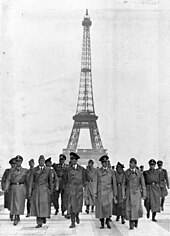 The late 1930s saw a series of violations of the Versailles Treaty by Germany, however, France and Britain refused to act.[114] In 1938, Hitler annexed Austria in an attempt to unite all German-speakers under his rule. Next, he annexed a German-speaking area of Czechoslovakia. Britain and France agreed to recognize his rule over that land and in exchange Hitler agreed not to expand his empire further. In a matter of months, however, Hitler broke the pledge and annexed the rest of Czechoslovakia. Despite this, the British and French chose to do nothing, wanting to avoid war at any cost. Hitler then formed a secret non-aggression pact with the Soviet Union, despite the fact that the Soviet Union was Communist and Germany was Nazi. Also in the 1930s, Italy conquered Ethiopia. The Soviets too began annexing neighboring countries. Japan began taking aggressive actions towards China. After Japan opened itself to trade with the West in the mid-19th century, its leaders learned to take advantage of Western technology and industrialized their country by the end of the century. By the 1930s, Japan's government was under the control of militarists who wanted to establish an empire in the Asia-Pacific region. In 1937, Japan invaded China. PoWs of the Empire of Japan in 1943. The Fall of Singapore to Japan marked the greatest defeat in British military history .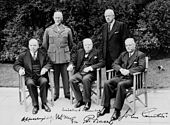 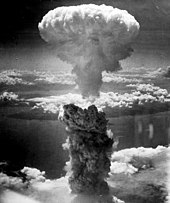 In 1939, German forces invaded Poland, and soon the country was divided between the Soviet Union and Germany. France and Britain declared war on Germany, Axis Powers . Germany next turned its attention to Britain.
Hitler attempted to defeat the British using only air power. In the Battle of Britain, German bombers destroyed much of the British air force and many British cities. Led by their prime minister, the defiant Winston Churchill, the British refused to give up and launched air attacks on Germany. Eventually, Hitler turned his attention from Britain to the Soviet Union. In June 1941, German forces invaded the Soviet Union and soon reached deep into Russia, surrounding Moscow, Leningrad, and Stalingrad. Hitler's invasion came as a total surprise to Stalin; however, Hitler had always believed sooner or later Soviet Communism and what he believed were the "inferior" Slavic peoples had to be wiped out. The United States attempted to remain neutral early in the war. However, a growing number feared the consequences of a Fascist victory. President Roosevelt began sending weapons and support to the British, Chinese, and Soviets. Also, the U.S. placed an embargo against the Japanese, as they continued their war with China and conquered many colonies formerly ruled by the French and Dutch, who were now under German rule. In 1941, Japan launched a surprise Axis Powers . Other allied nations included Canada, Australia, New Zealand, South Africa and China.
In the air raids and Sydney suffered naval attack. U.S. General Douglas MacArthur, based in Melbourne, Australia became "Supreme Allied Commander of the South West Pacific" and the foundations of the post war Australia-New Zealand-United States Alliance were laid.
In May 1942, the Royal Australian Navy and U.S. Navy engaged the Japanese in the Battle of the Coral Sea and halted the Japanese fleet headed for Australian waters. The Battle of Midway in June effectively defeated the Japanese navy. In August 1942, Australian forces inflicted the first land defeat on advancing Japanese forces at the Battle of Milne Bay in the Australian Territory of New Guinea.[115] By 1942, German and Italian armies ruled Norway, the Low Countries, France, the Balkans, Central Europe, part of Russia, and most of North Africa. Japan by this year ruled much of China, Southeast Asia, Indonesia, the Philippines, and many Pacific Islands. Life in these empires was cruel – especially in Germany, where the Holocaust was perpetrated. Eleven million people – six million of them Jews – were systematically murdered by the German Nazis by 1945.[116][117] From 1943 on, the Allies gained the upper hand. American and British troops first liberated North Africa from the Germans and Italians. Next they invaded Italy, where Mussolini was deposed by the king and later was killed by Italian partisans. Italy surrendered and came under Allied occupation. After the liberation of Italy, American, British, and Canadian troops Soviet invasion of many of Japan's occupied territories in the east, led Japan to surrender.
After the war the U.S., Britain and the Soviet Union attempted to cooperate. German and Japanese military leaders responsible for atrocities in their regimes were put on trial and many were executed. The international organization the United Nations was created. Its goal was to prevent wars from breaking out as well as provide the people of the world with security, justice and rights. The period of post-war cooperation ended, however, when the Soviet Union rigged elections in the occupied nations of Central and Eastern Europe to allow for Communist victories. Soon, all of Eastern and much of Central Europe had become a series of Communist dictatorships, all staunchly allied with the Soviet Union. Germany following the war had been occupied by British, American, French, and Soviet forces. Unable to agree on a new government, the country was divided into a democratic west and Communist east. Berlin itself was also divided, with West Berlin becoming part of West Germany and East Berlin becoming part of East Germany. Meanwhile, the former Axis nations soon had their sovereignty restored, with Italy and Japan regaining independence following the war. World War II had cost millions of lives and devastated many others. Entire cities lay in ruins and economies were in shambles. However, in the Allied countries, the people were filled with pride at having stopped Fascism from dominating the globe, and after the war, Fascism was all but extinct as an ideology. The world's balance of power also shifted, with the United States and Soviet Union being the world's two superpowers. Fall of the Western empires: 1945–1999 Following World War II, the great colonial empires established by the Western powers beginning in early modern times began to collapse. There were several reasons for this. Firstly, World War II had devastated European economies and had forced governments to spend great deals of money, making the price of colonial administration increasingly hard to manage. Secondly, the two new superpowers following the war, the United States and Soviet Union were both opposed to imperialism, so the now weakened European empires could generally not look to the outside for help.[citation needed] Thirdly, Westerners increasingly were not interested in maintaining and even opposed the existence of empires.[citation needed] The fourth reason was the rise of independence movements following the war. The future leaders of these movements had often been educated at colonial schools run by Westerners where they adopted Western ideas like freedom, equality, self-determination and nationalism, and which turned them against their colonial rulers.[citation needed]  The first colonies to gain independence were in Asia. In 1946, the U.S. granted independence to the Hindu country of India and the smaller, largely Muslim nation of Pakistan in 1947.
In 1948 Burma gained independence from Britain, and in 1945 Indonesian independence, which the Netherlands recognised in 1949 after a four-year armed and diplomatic struggle. Independence for French Indochina came only after a great conflict. After the withdrawal of Japanese forces from the colony following World War II, France regained control but found it had to contend with an independence movement that had fought against the Japanese. The movement was led by the Vietnamese Ho Chi Minh, leader of the Vietnamese Communists. Because of this, the U.S. supplied France with arms and support, fearing Communists would dominate South-east Asia.[118] In the end though, France gave in and granted independence, creating Laos, Cambodia, Communist North Vietnam, and South Vietnam .
In the Middle East, following World War II, Britain had granted independence to the formerly Ottoman territories of Mesopotamia, which became Zionists declared the state of Israel on 14 May 1948.
The other major center of colonial power, Africa, was freed from colonial rule following World War II as well. Egypt gained independence from Britain and this was soon followed by Ghana and Tunisia. One violent independence movement of the time was fought in Algeria, in which Algerian rebels went so far as to kill innocent Frenchmen. In 1962, however, Algeria gained independence from France. By the 1970s the entire continent had become independent of European rule, although a few southern countries remained under the rule of white colonial minorities. By the close of the 20th century, the European colonial Empires had ceased to exist as significant global entities. Sunset for the Dutch Empire retained a few Caribbean islands as constituent countries of the Kingdom of the Netherlands . Spain had lost its overseas possessions, but its legacy was vast – with Latin culture remaining throughout South and Central America. Along with Portugal and France, Spain had made Catholicism a global religion.
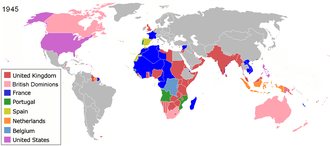 Of Europe's empires, only the Russian Empire remained a significant geo-political force into the late 20th century, having morphed into the Soviet Union and Warsaw Pact, which, drawing on the writings of the German Karl Marx, established a socialist economic model under Communist dictatorship, which ultimately collapsed in the early 1990s.[119] Adaptations of Marxism continued as the stated inspiration for Governments in Central America and Asia into the 21st century – though only a handful survived the end of the Cold War. The end of the Western Empires greatly changed the world. Although many newly independent nations attempted to become democracies, many slipped into military and autocratic rule. Amid power vacuums and newly determined national borders, civil war also became a problem, especially in Africa, where the introduction of firearms to ancient tribal rivalries exacerbated problems. The loss of overseas colonies partly also led many Western nations, particularly in continental Europe, to focus more on European, rather than global, politics as the European Union rose as an important entity. Though gone, the colonial empires left a formidable cultural and political legacy, with English, French, Spanish, Portuguese, Russian and Dutch being spoken by peoples across far flung corners of the globe. European technologies were now global technologies – religions like Catholicism and Anglicanism, founded in the West, were booming in post colonial Africa and Asia. Parliamentary (or presidential) democracies, as well as rival Communist style one party states invented in the West had replaced traditional monarchies and tribal government models across the globe. Modernity, for many, was equated with Westernisation. Cold War: 1945–1991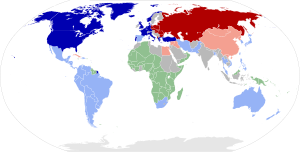 From the end of World War II almost until the start of the 21st century, Western and world politics were dominated by the state of tensions and conflict between the world's two East Germans constructed the Berlin Wall, to prevent East Berliners from escaping to the "freedom" of West Berlin. The Berlin Wall would come to represent the Cold War around the world.[120]
Rather than revert to isolationism, the United States took an active role in global politics following World War II to halt Communist expansion. After the war, Communist parties in Western Europe increased in prestige and number, especially in Italy and France, leading many to fear the whole of Europe would become Communist. The U.S. responded to this with the North Atlantic Treaty Organization, or NATO. The treaty was signed by the United States, Canada, the Low Countries, Norway, Denmark, Iceland, Portugal, Italy, France, and Britain. NATO members agreed that if any one of them were attacked, they would all consider themselves attacked and retaliate. NATO would expand as the years went on, other nations joined, including Greece, Turkey, and West Germany. The Soviets responded with the Warsaw Pact, an alliance which bound Central and Eastern Europe to fight with the United States and its allies in the event of war.
space race .One of the first actual conflicts of the Cold War took place in China. Following the withdrawal of Japanese troops after World War II, China was plunged into Chinese Communists against Nationalists, who opposed Communism. The Soviets supported the Communists while the Americans supported the Nationalists. In 1949, the Communists were victorious, proclaiming the People's Republic of China. However, the Nationalists continued to rule the island of Taiwan off the coast. With American guarantees of protection for Taiwan, China did not make an attempt to take over the island. A major political change in East Asia in this period was Japan's becoming a tolerant, democratic society and an ally of the United States. In 1950, another conflict broke out in Asia, this time in Korea.
The peninsula had been divided between a Communist North and non-Communist South in 1948 following the withdrawal of American and Soviet troops. In 1950, the North Koreans invaded South Korea, wanting to united the land under Communism. The UN condemned the action, and, because the Soviets were boycotting the organization at the time and therefore had no influence on it, the UN sent forces to liberate South Korea. Many nations sent troops, but most were from America. UN forces were able to liberate the South and even attempted to conquer the North. However, fearing the loss of North Korea, Communist China sent troops to the North. The U.S. did not retaliate against China, fearing war with the Soviet Union, so the war stalemated. In 1953 the two sides agreed to a return to the pre-war borders and a de-militarization of the border area. The world lived in the constant fear of World War III in the Cold War. Seemingly any conflict involving Communism might lead to a conflict between the Warsaw pact countries and the NATO countries. The prospect of a third world war was made even more frightening by the fact that it would almost certainly be a nuclear war. In 1949 the Soviets developed their first atomic bomb, and soon both the United States and Soviet Union had enough to destroy the world several times over. With the development of missile technology, the stakes were raised as either country could launch weapons from great distances across the globe to their targets. Eventually, Britain, France, and China would also develop nuclear weapons. It is believed that Israel developed nuclear weapons as well. One major event that nearly brought the world to the brink of war was the Cuban Missile Crisis. In the 1950s a revolution in Cuba had brought the only Communist regime in the Western Hemisphere to power. In 1962, the Soviets began constructing missile sites in Cuba and sending nuclear missiles. Because of its close proximity to the U.S., the U.S. demanded the Soviets withdraw missiles from Cuba. The U.S. and Soviet Union came very close to attacking one another, but in the end came to a secret agreement in which the NATO withdrew missiles in exchange for a Soviet withdrawal of missiles from Cuba. 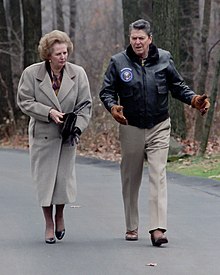 The next great Cold War conflict occurred in Southeast Asia. In the 1960s, North Vietnam invaded South Vietnam, hoping to unite all of Vietnam under Communist rule. The U.S. responded by supporting the South Vietnamese. In 1964, American troops were sent to "save" South Vietnam from conquest, which many Americans feared would lead to Communist dominance in the entire region. The Vietnam War lasted many years, but most Americans felt the North Vietnamese would be defeated in time. Despite American technological and military superiority, by 1968, the war showed no signs of ending and most Americans wanted U.S. forces to end their involvement. The U.S. undercut support for the North by getting the Soviets and Chinese to stop supporting North Vietnam, in exchange for recognition of the legitimacy of mainland China's Communist government, and began withdrawing troops from Vietnam. In 1972, the last American troops left Vietnam and in 1975 South Vietnam fell to the North. In the following years Communism took power in neighboring Laos and Cambodia. By the 1970s global politics were becoming more complex. For example, France's president proclaimed France was a great power in and of itself. However, France did not seriously threaten the U.S. for supremacy in the world or even Western Europe.[citation needed] In the Communist world, there was also division, with the Soviets and Chinese differing over how Communist societies should be run. Soviet and Chinese troops even engaged in border skirmishes, although full-scale war never occurred. The last great armed conflict of the Cold War took place in Islamic World travelled to Afghanistan to defend that Muslim nation from conquest, calling it a Jihad, or Holy War. The U.S. supported the Jihadists and Afghan resisters, despite the fact that the Jihadists were vehemently anti-Western. By 1989 Soviet forces were forced to withdraw and Afghanistan fell into civil war, with an Islamic fundamentalist government, the Taliban taking over much of the country.
 The late 1970s had seen a lessening of tensions between the U.S. and Soviet Union, called Round Table Talks between the government and the Solidarity-led opposition led to semi-free elections in 1989. Elections in Poland where anti-communist candidates won a striking victory sparked off a succession of peaceful anti-communist revolutions in Central and Eastern Europe known as the Revolutions of 1989 . Soon, Communist regimes throughout Europe collapsed.
In Germany, after calls from Reagan to Gorbachev to tear down the Berlin Wall, the people of East and West Berlin tore down the wall and East Germany's Communist government was voted out. East and West Germany unified to create the country of Germany, with its capital in the reunified Berlin. The changes in Central and Eastern Europe led to calls for reform in the Soviet Union itself. A failed coup by hard-liners led to greater instability in the Soviet Union, and the Soviet legislature, long subservient to the Communist Party, voted to abolish the Soviet Union in 1991. What had been the Soviet Union was divided into many republics. Although many slipped into authoritarianism, most became democracies. These new republics included Russia, Ukraine, and Kazakhstan. By the early 1990s, the West and Europe as a whole was finally free from Communism.[121] Following the end of the Cold War, Communism largely died out as a major political movement. After the fall of USSR, the United States became the world's only superpower.[122] Western countries: 1945–1980United States: 1945–1980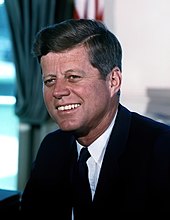 Following World War II, there was an unprecedented period of prosperity in the United States. The majority of Americans entered the middle class and moved from the cities into surrounding suburbs, buying homes of their own. Most American households owned at least one car, as well as the relatively new invention, the television. Also, the American population greatly increased as part of the so-called "baby boom" following the war. For the first time following the war, large of numbers of non-wealthy Americans were able to attend college. Following the war, black Americans started what has become known as the Voting Rights Act were passed in 1964, banning measures that had prevented blacks from voting and outlawing segregation and discrimination in the U.S.
Civil Rights leaders in 1964.In politics, the Democratic and Republican parties remained dominant. In 1945, the Democratic party relied on Southerners, whose support went back to the days when Democrats defended a state's right to own slaves, and Northeasterners and industrial Mid-Westerners, who supported the pro-labor and pro-immigrant policies of the Democrats. Republicans tended to rely on middle-class Protestants from elsewhere in the country. As the Democrats began championing civil rights, however, Southern Democrats felt betrayed, began voting Republican. Presidents from this period were . The years 1945–1980 saw the expansion of federal power and the establishment of programs to help the elderly and poor pay for medical expenses.By 1980, many Americans had become pessimistic about their country. Despite its status as one of only two superpowers, the Vietnam War as well as the social upheavals of the 1960s and an economic downturn in the 1970s led America to become a much-less confident nation. Europe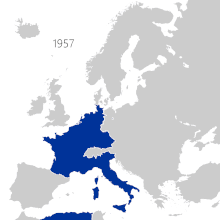 At the close of the war, much of Europe lay in ruins with millions of homeless refugees. A souring of relations between the Western Allies and the Soviet Union then saw Europe split by an Iron Curtain, dividing the continent between West and East. In Western Europe, democracy had survived the challenge of Fascism and began a period of intense rivalry with Eastern Communism, which was to continue into the 1980s. France and Britain secured themselves permanent positions on the newly formed United Nations Security Council, but Western European empires did not long survive the war, and no one Western European nation would ever again be the paramount power in world affairs.[123] Despite these immense challenges however, Western Europe again rose as an economic and cultural powerhouse. Assisted first by the European Common Market, Western Europe quickly re-emerged as a global economic power house. The vanquished nations of Italy and West Germany became leading economies and allies of the United States. So marked was their recovery that historians refer to an Italian economic miracle and in the case of West Germany and Austria the Wirtschaftswunder (German for "economic miracle").
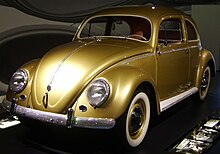 Facing a new power balance between the Soviet East and American West, Western European nations moved closer together. In 1957, Belgium, France, the Netherlands, West Germany, Italy and Luxembourg signed the landmark Treaty of Rome, creating the European Economic Community, free of customs duties and tariffs, and allowing the rise of a new European geo-political force.[123] Eventually, this organization was renamed the European Union or (EU), and many other nations joined, including Britain, Ireland, and Denmark. The EU worked toward economic and political cooperation among European nations. Between 1945 and 1980, Europe became increasingly socialist.[ Europe had many important political leaders during this time. Charles de Gaulle, leader of the French government in exile during World War II, served as France's president for many years. He sought to carve out for France a great power status in the world. Although Europe as a whole was relatively peaceful in this period, both Britain and Spain suffered from acts of terrorism. In Britain, Basques, an ethnic minority in north-eastern Spain. Both these terrorist campaigns failed, however.[126][127]
For Greece, Spain and Portugal, ideological battles between left and right continued and the emergence of parliamentary democracy was troubled.[ British Empire and Commonwealth 1945–1980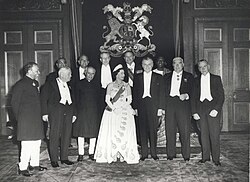 Between 1945 and 1980, the British Empire was transformed from its centuries old position as a global colonial power, to a voluntary association known as the Commonwealth of Nations – only some of which retained any formal political links to Britain or its monarchy.[128] Some former British colonies or protectorates disassociated themselves entirely from Britain. BritainThe popular war time leader Winston Churchill was swept from office at the 1945 election and the Labour Government of Clement Attlee introduced a program of nationalisation of industry and introduced wide-ranging social welfare. Britain's finances had been ravaged by the war and John Maynard Keynes was sent to Washington to negotiate the massive Anglo-American loan on which Britain relied to fund its post-war reconstruction.[129] India was granted Independence in 1947 and Britain's global influence rapidly declined as decolonisation proceeded. Though the USSR and United States now stood as the post war super powers, Britain and France launched the ill-fated Suez intervention in the 1950s, and Britain committed to the Korean War. From the 1960s The Troubles afflicted Northern Ireland, as British Unionist and Irish Republican paramilitaries conducted campaigns of violence in support of their political goals. The conflict at times spilled into Ireland and England and continental Europe. Paramilitaries such as the IRA (Irish Republican Army) wanted union with the Republic of Ireland while the UDA (Ulster Defence Association) were supporters of Northern Ireland remaining within the United Kingdom. In 1973, Britain entered the European Common Market, stepping away from imperial and commonwealth trade ties. Inflation and unemployment contributed to a growing sense of economic decline – partly offset by the exploitation of North Sea Oil from 1974. In 1979, the electorate turned to Conservative Party leader Margaret Thatcher, who became Britain's first female prime minister. Thatcher launched a radical program of economic reform and remained in power for over a decade. In 1982, Thatcher dispatched a British fleet to the Falkland Islands which successfully repelled an Argentine invasion of the British Territory, demonstrating that Britain could still project power across the globe.[123]
CanadaCanada continued to evolve its own national identity in the post-war period. Although it was an independent nation, it remained part of the British Commonwealth and recognized the British monarch as the Canadian monarch as well. Following the war, French and English were recognized as co-equal official languages in Canada,[130] and French became the only official language in the French-speaking province of Quebec.[131] Referendums were held in both 1980 and 1995 in which Quebecers, however, voted not to secede from the union. Other cultural changes Canada faced were similar to those in the United States.[132] Racism and discrimination largely disappeared in the post-war years, and dual-income families became the norm. Also, there was a rejection of traditional Western values by many in Canada.[133] The government also established universal health care for its citizens following the war.[134] Australia and New Zealand: 1945–1980 Following World War II, Australia and New Zealand enjoyed a great deal of prosperity along with the rest of the West. Both countries remained constitutional monarchies within the evolving Commonwealth of Nations and continued to recognise British monarchs as head of their own independent Parliaments. However, following British defeats by the Japanese in World War II, the post-war decline of the British Empire, and entry of Britain into the European Economic Community in 1973, the two nations re-calibrated defence and trade relations with the rest of the world.
Following the multicultural immigration programs with waves of economic and refugee migrants establishing bases for large Southern European, East Asian, Middle Eastern, and South Pacific islander communities. Trade integration with Asia expanded, particularly through good post-war relations with Japan.
The civil rights movement in North America. The Fraser government became a vocal critic of white-minority rule in Apartheid South Africa and Rhodesia, concluding the Gleaeagles Agreement in 1977.[135]
The arts also diversified and flourished over the period – with Australian Aboriginal Art began to find international recognition and influence.
Western culture: 1945–1980
|


